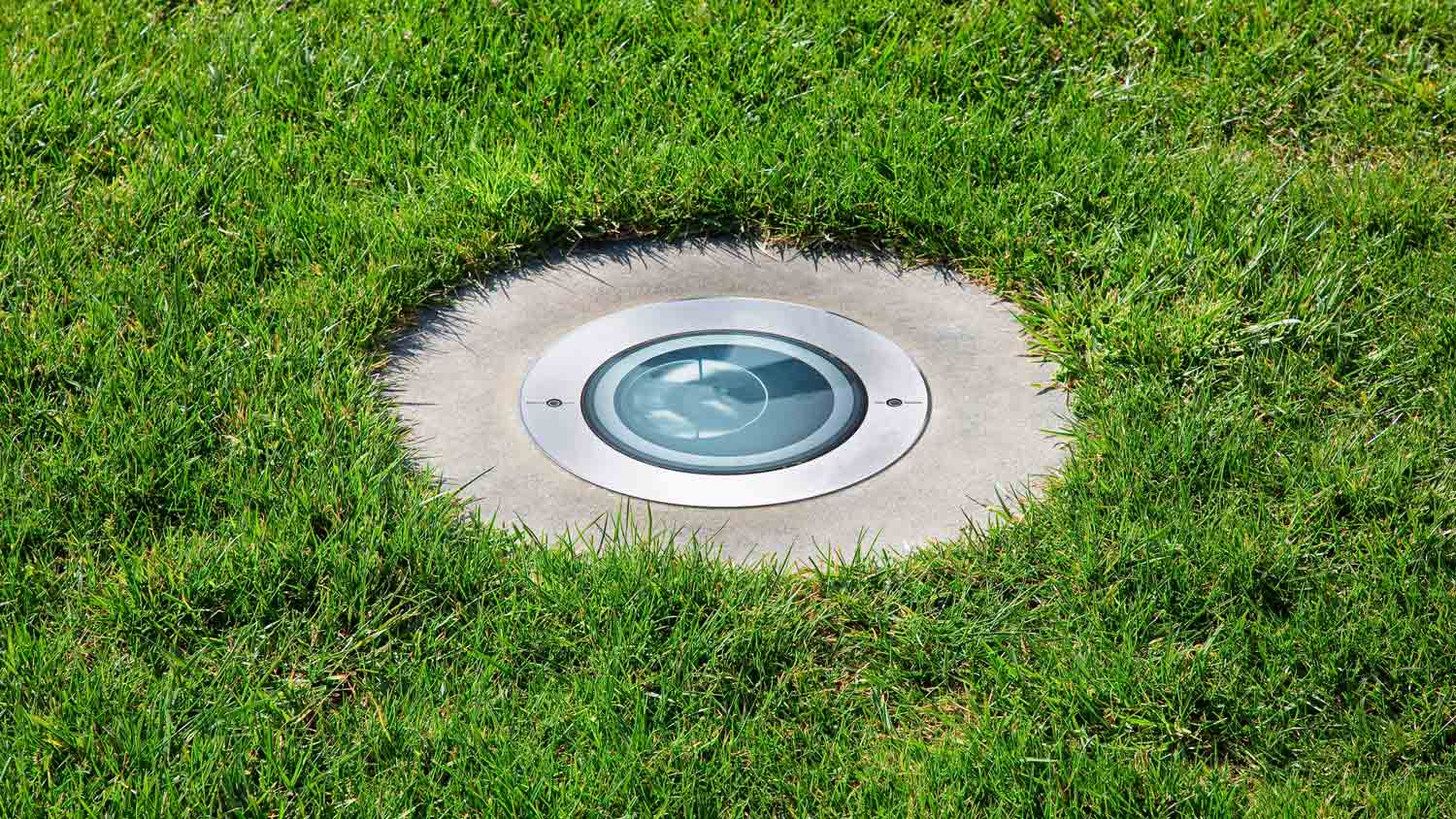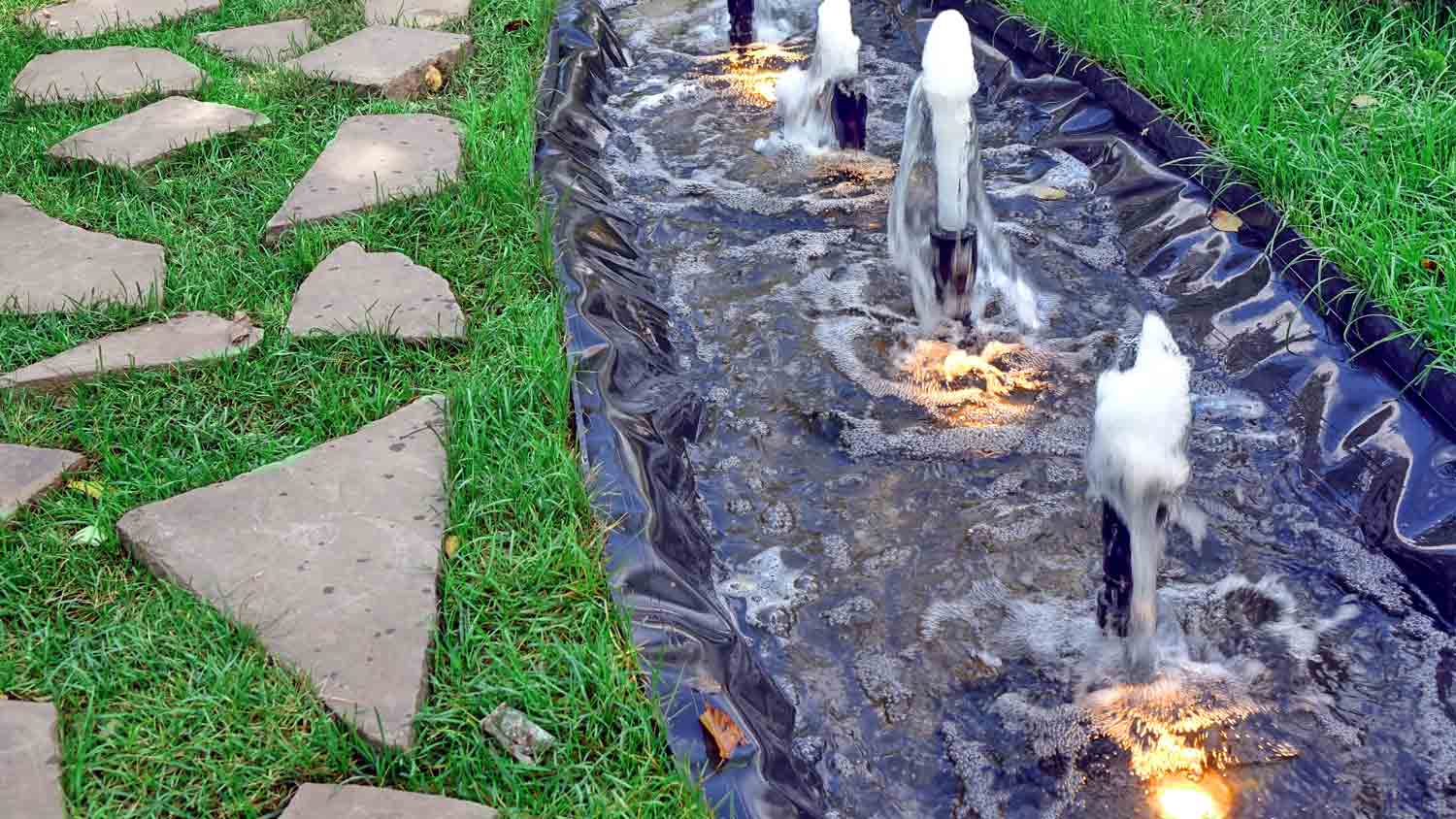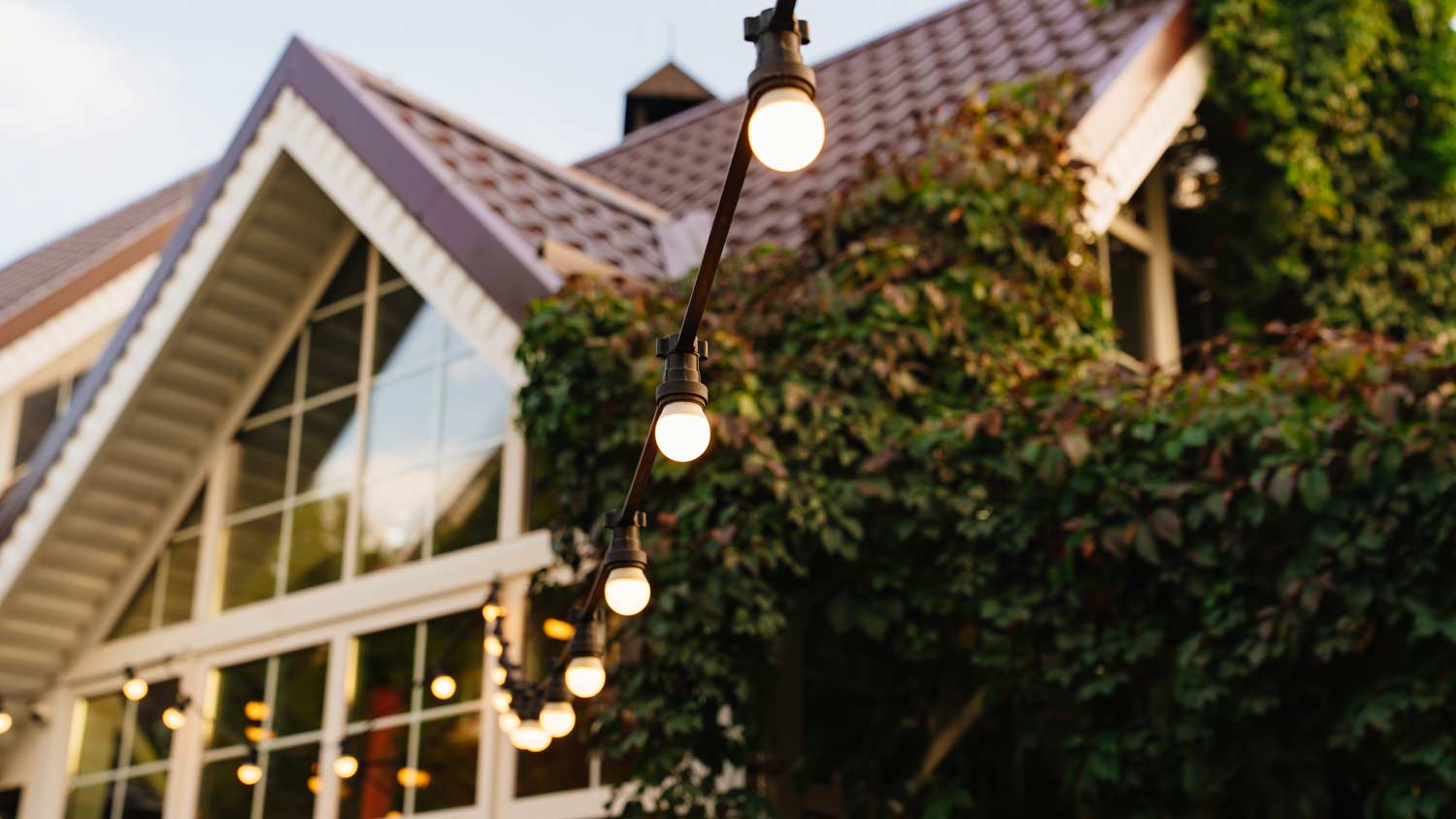10 Types of Outdoor Lighting to Consider for Your Home
Light up the night


Your outdoor space should feel safe, comfortable, and well-lit—which is why choosing from the many types of outdoor lights is a key consideration. Depending on the nature of your space and what you’re trying to achieve, different types of lighting might make more sense. In this guide, we’ll break down 10 of the most common types of outdoor lighting options and explain when you might use each one in your own space. Let’s take a look.
1. Spotlights & Floodlights

Spotlights and floodlights are grouped together because they serve a very similar purpose. Each of these fixtures produces an angled beam that allows you to shine light on specific points. However, when considering flood lights vs. spotlights, there are still some considerations to make.
Spotlights tend to have a narrower beam, which is great for highlighting a part of a home, an outdoor structure like a gazebo, or perhaps a large tree or other landscaping feature. Floodlights tend to cast a wider beam of light, which is great for brightening up larger outdoor areas at night. The angle of both spotlights and floodlights can be adjusted, making them a versatile choice for general outdoor lighting.
| Pros | Cons |
|---|---|
| Large light beam | Expensive |
| Bright, even light | Can annoy neighbors |
| Add curb appeal | Frequent maintenance |
Best For: Generally brightening up an area for safety and security
2. Path Lights & Garden Lights

Path and garden lights refer to small individual lights that are dotted around a path or a garden bed. In the case of path lights, these are used to light up walkways at night, making them easier to see and walk on. Garden lights are mainly aesthetic, allowing your beautiful flowers and plants to be visible even at night-time.
These lights are often solar-powered and can be simply staked into the ground, meaning they require less upkeep and setup. Plus, they come in a huge variety of styles, so you’ll always find something that suits your space.
| Pros | Cons |
|---|---|
| Easy to customize | Need multiples |
| Lights paths | Wear out quickly |
| Often solar-powered | Easy to steal |
Best For: Lighting walkways and adding light accents to gardens
3. In-Ground Well Lights

For a low-profile outdoor light solution, in-ground well lights can be a great option. In-ground well lights are unobtrusive since the light itself sits in the ground. This, combined with the variety of covers designed to direct the light in different ways, makes these a very versatile addition—whether you want to add subtle light to a driveway or patio, or perhaps dot some illumination around a lawn. Although it might take a little time to learn how to install landscape lights like these, it’s still a completely achievable DIY project.
| Pros | Cons |
|---|---|
| Subtle when off | Can be water-damaged |
| Versatile styles | High cost |
| Elegant | Prone to breaking |
Best For: Subtly lighting an area from the ground without drawing attention to the fixture
4. Wall Lights & Lanterns

Wall lights and lanterns are some of the most widely used types of lighting in outdoor spaces. As the name suggests, these fixtures need to be secured to some kind of wall. Typically, this will be an outer wall on your home, but you can also attach them to garages, sheds, and other durable structures to attractively light up their exterior.
| Pros | Cons |
|---|---|
| Safe from weather | Pricey installation |
| Good for doors | Tricky power hook-up |
| Huge range of styles | Small light beam |
Best For: Highlighting building and landscaping features
5. Gooseneck Lights

Gooseneck lights are similar to wall lights and lanterns with one main difference: the long arm that attaches the light to the wall. These curved arms are similar to the neck of the goose, hence the funny name. Depending on your needs, you can choose an arm length and angle to perfectly light up aspects of a building or your landscaping. They’re commonly seen hanging over entryways and exits or as a method of downlighting a certain element of your landscape.
| Pros | Cons |
|---|---|
| Very versatile | Needs sturdy walls |
| Focused lighting | Needs home power |
| Variety of angles | Noticeable in day |
Best For: Illuminating doors or downlighting landscaping
6. Underwater Lights & Fountain Lights

No outdoor water feature would be complete without a little lighting to make it pop when the sun goes down. There are several kinds of lights for this purpose, including waterproof lights to place inside a pond or fountain, as well as leak and rust-proof lights used to surround the perimeter of a water feature and uplight it at night.
| Pros | Cons |
|---|---|
| Waterproof | Hazardous if damaged |
| Light tricky spots | Tricky installation |
| Subtle | Hard to change bulbs |
Best For: Beautifying ponds, fountains, and other water features at night
7. Step Lights

Say goodbye to stumbling up and down your outdoor stairs in the dark! If you’re looking for a subtle, elegant way to make your stairs safer (and nicer to look at), step lights are the way to go. Typically placed on either the sides or the front-facing surface of each step, these lights are a great way to make stairs easier to use at night for you and your guests. They’re also commonly used as deck lighting for subtle illumination on the floor.
| Pros | Cons |
|---|---|
| Safety | Can cause glare |
| Weatherproof | Expensive to install |
| Elegant look | Inflexible setup |
Best For: Making outdoor staircases safer to use at night
8. Weatherproof Pendant Lights

Pendant lights are an attractive way to provide a wide light over a frequently-used outdoor space. They’re most commonly seen under gazebos or covered patios, though you can also hang them from the eaves of your home for an elegant, semi-industrial look.
| Pros | Cons |
|---|---|
| Provides ample light | Expensive |
| Retro aesthetic | Less versatile |
| Dimmer-compatible | Hard to move/adjust |
Best For: General lighting for covered patios, porches, and gazebos
9. Motion Sensor Lights

Motion sensor lights serve two main purposes: home security and functional lighting for yourself and your guests. A motion-detector light can be a great deterrent to any unwelcome guests on your property, likely encouraging them to leave. At the same time, they’re a useful way to light up areas of your home, like a path or a side entrance, without paying the bill for a constantly running light that isn’t often used. It’s also quite easy to learn how to install a light fixture and connect it to a motion sensor yourself.
| Pros | Cons |
|---|---|
| Deter intruders | Placement is key |
| Save money on power | More expensive |
| Calibration options | May turn on in error |
Best For: Side and back entrances, garage doors, alleyways, walkways
10. String Lights

Whimsical, beautiful, and easy to install, string lights are growing in popularity as a way to add a touch of charm to outdoor spaces. It’s common to see them hung around deck railings, fastened to exterior walls next to a patio, or lining fences to highlight the perimeter of a property. These are also some of the easiest lights to install—just hang them up and plug them in!
| Pros | Cons |
|---|---|
| Inexpensive | Needs extension cord |
| Easy to move around | Bulbs burn quickly |
| Warm, cozy feel | No functional light |
Best For: Adding finishing touches to a patio, deck, porch, or gazebo
How to Choose the Right Type of Outdoor Lighting
When it comes to lighting an outdoor space, you want to strike a good balance between aesthetics and functionality. A subtle, barely-there fixture like an in-ground well light is great, but it won’t provide the powerful illumination that a floodlight or a hanging pendant lamp will. Motion sensor lights are useful for keeping your property safe, but they’re probably not the most reliable choice for illuminating outdoor staircases when compared to a set of step lights. Considering outdoor lighting tips like these will help make your decision easier.
Here’s a breakdown of some of the common goals people have with outdoor lighting, along with the best lighting fixture types for that scenario:
Aesthetics: Underwater and fountain lights, garden lights, string lights
Accent Landscaping or building features: Spotlights, wall lights and lanterns, gooseneck lights, in-ground well lights
General lighting for specific area: Floodlights, pendant lights
Home safety and security: Step lights, path lights, motion sensor lights
Cost to Install Outdoor Lighting
Depending on the number and type of fixtures you’ll be looking to add, it could cost you between $2,500 and $6,000 in labor and materials to work with an outdoor lighting expert.
DIY vs Hiring a Pro
DIY outdoor lighting is completely achievable, though the job can become more complex depending on the type of fixture you plan to install. If you’re looking to stick a few solar-powered garden lights in the ground, it should take you all of fifteen minutes. But if you’re thinking about adding a few wall lamps to the exterior of your home, you’ll need to have an understanding of electrical wiring and installation methods to do the job right. There are plenty of outdoor lighting installation guides out there to help with this step.
Of course, you could always save yourself the time and hassle, and hire an outdoor lighting company near you instead.





- Should I Install Outdoor Lighting? Read This First
- 10 Outdoor Lighting Trends to Enhance Your Home’s Curb Appeal
- 5 Different Types of Security Lighting: Which One Is Best for Your Home?
- What Are the Best Types of Light Fixtures To Install in Your Home?
- 6 of the Best Types of Porch Lights to Illuminate Your Space
- Top 6 Landscape Lighting Solutions That Are Easy on Your Wallet
- Shine a Spotlight on Your Exterior With These 11 Outdoor Lighting Tips
- 12 Whimsical DIY Outdoor LED Lights Ideas for Enchanted Evenings
- 20 Deck Lighting Ideas to Brighten Up Your Outdoor Living Space
- Choosing the Best Christmas Lights to Illuminate Your Holidays










